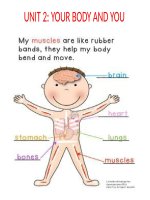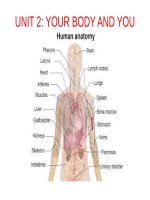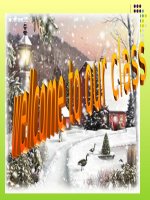ANH 6 UNIT 10 OUR HOUSES IN THE FUTUREMỚI ( 3 CÔT)
Bạn đang xem bản rút gọn của tài liệu. Xem và tải ngay bản đầy đủ của tài liệu tại đây (270.4 KB, 19 trang )
Planning date: 26/03/2019
Period 80 :
UNIT 10: OUR HOUSES IN THE FUTURE
Lesson 1: Getting Started – My future house
I. Objectives:
By the end of this lesson, students can know more about types of houses, modern
appliances and how they can help us.
II. Language Focus:
1. Vocabulary: the lexical items related to “Our houses in the future”.
2. Structures: Will + V for the future and might + V for future possibility
III. Method: Communicative approach
IV. Teaching ads: Course book, CD player, picture.
Steps
Learning activities
Modes
Warm up
Do you live in a house or in an apartment?
* What appliances are there in your houses?
Whole class
* What furniture does your house have?
* What does a washing machine, a dish washer, a T.V
5ms
help you?
- Ask Ss some questions about their houses:
- Lead Ss to the topic of the lesson.
Getting
1. Listen and read
started
- Ask Ss to look at the picture and answer some Whole class
questions:
* Who are they? ( Nick and Phong)
* What is Phong doing? (drawing a picture)
* What is his picture of? ( of a UFO)
* This UFO is his future house. What is there around the
house?
* Nick and Phong are talking about his future house.
What tense do they use in the conversation?
Pairs
)
15ms
- Ask Ss to look through the conversation before
listening.
Individuals
- Play the recording. Ss listen and read.
- Call on some pairs to practice the conversation in front
of the class.
1a. Complete the table
- Ask SS to listen to the recording to tell which family Individuals
members Mi talks about.
- Play the recording
Whole class
- Ask Ss to give the answers without reading the
conversation again.
- Ask Ss to read the conversation and check their
answers.
- Check SS’ answers.
Key:
Type of house UFO
Location
In the
mountains
Surrounding
Many tall old trees
Number of
20
rooms
Individual
Appliances in A wireless
the room
T.V
1b. Complete the sentences
- Ss read the conversation again and find the appropriate
information to complete the sentences.
- Check Ss’ answers:
Key:
1. mountains
2. many tall old trees
3. 20
4 . wireless T.V
Doing
2. Matching
- Ask Ss to match the prepositions with the pictures on
page 39.
- Check Ss’ answers:
Key:
1- c 2. a 3. e 4. b 5.d
- Focus Ss on how to pronounce these prepositions and
their meanings.
3- What adjs can you think of to describe the houses in
2
- T asks Ss to work in pairs to find out some adjectives
that can be used to describe the houses.
- T gets feedback and asks the other to give their ideas.
Individuals
Whole class
Individuals
Pairs
15ms
Performing
9ms
Homework
1m
- T asks:
*What do you think about the space houseboat?
Whole class
* I think they are beautiful………
- SS work in pairs, ask and answer these questions about
the pictures.
- T calls some SS to perform before class.
- Read the phrases
Where will your future be? Tick the place where you
want your future house to be located.
- SS do it individually- then practice asking and
answering the question.
- T calls some pairs to perform before class
Individuals
*Which house do you like best?
*I like the palace
Pairs
*Why?
Whole class
* Because it’s big
Game
OUTSIDE MY WINDOW
group work
in group, describe to your classmate what you can see
outside the window of your future house. Your group
tries to guess where your house is locaed
A: Outside my house , I can see the beach and the
water . I see children playing . Where is my house ?
B: It’s by the sea
A: Correct
- Write a paragraph about your future house.
Whole class
- Prepare next lesson
(A closer look 1)
Planning date: 28/03/2019
Period 81
UNIT 10: OUR HOUSES IN THE FUTURE
Lesson 2: A Closer Look 1
I. Objectives:
By the end of this lesson, students can Pronounce correctly the sounds /dr/ and /tr/in
isolation and in context; Use the lexical items related to the topic “our houses in the
future”
II. Language Focus:
1. Vocabulary: the lexical items related to “Our houses in the future”.
2. Structures: Will + V for the future and might + V for future possibility
III. Method: Communicative approach
IV. Teaching ads: Course book, CD player, picture.
V. Procedures:
Steps
Warm up
5ms
Vocabulary
15ms
Learning activities
Picture dscription :
- look at the picture and answer what is it ?
wireless TV
Modern fridge
automatic dishwashee
automatic washing machine
Exercise 1: Put the appliances into the appropriate
columns
-- Play the recording.
- Ask Ss to listen and repeat the words.
- Ask for more words for each group.
- T explains how to do this task. Then ask Ss
individually to put the words into correct columns
- Get feedback and correct
- Ask Ss to give more words about appliances.
Living room
-Wireless T.V
Bedroom
-Wireless T.V
-Hi-tech robot
kitchen
-Modern fridge
-Automatic dishwasher
bathroom
-automatic washing
machine
Activity 2: Exercise 2
*What can the appliances do? Match the appliances in
A with the things they can do in B.
- Ss work ind. Then write the sentences on the board.
-Get feedback and correct
1.c 2. d 3. b 4.e 5. a
Modes
Whole class
Individuals
Whole class
Whole class
Activity 3: Exercise 3
- T asks SS to look at the exercise 2 again then asks:
*What does a wireless T.V do?
*It helps us watch T.V programmes from space.
-T introduces the structure with HELP
“HELP SO DO/ TO DO St”
- T lets SS to read the sample, then ask them to work in
pairs to practice the conversation again.
- Call some SS to perform before class
Pairs
Whole class
Pronunciation PRONUNCIATION /dr/ and /tr/
Activity 4:
-Let Ss practise the sounds /dr/ , /tr/ together. Model the
two sounds with try and dry
15ms
- Play the recording and ask Ss to listen and repeat the
chants sentence by sentence.
- SS write the words in columns. Check their answers in
groups.
- T calls some SS to write the answers on the board
Whole class
Individuals
Whole class
/dr/
/tr/
Dry, drops, drip, dripping Countryside, travel, train,
tractor, track
- Ask Ss to say the words in the table again
- Ask Ss to SS add some more words
Individuals
Pairs
Whole class
Performing
9ms
Homework
Outcome
- Play the recording for Ss to repeat each line of the
conversation.
- Ask Ss to practice the conversation in pairs
- Call on some pairs to practice the conversation..
- Correct their mistakes.
- Do exercises in the workbook
Whole class
Pairs
Whole class
1m
- Prepare for the next lesson: Closer look 2.
Planning date: 2/04/2019
Period 82
UNIT 10: OUR HOUSES IN THE FUTURE
Lesson 2: A Closer Look 2
I. Objectives:
By the end of this lesson, students can use will for the future and Modal verb MIGHT
for a unsure possibility in the future
II. Language Focus:
1. Vocabulary: the lexical items related to “Our houses in the future”.
2. Structures: Will + V for the future and might + V for future possibility
III. Method: Communicative approach
IV. Teaching ads: Course book, CD player, picture.
V. Procedures:
Steps
Warm-up:
15ms
Learning activities
Grammar
The simple future tense-- T asks SS to look at the
picture of Getting started and asks:
* What is Phong doing?
* What will his future house look like?
* Will it be in space?
- SS answer
- T introduces the grammar today: will for the
future
We use WIL + VBI to talk about actions we think
are likely happen in the fiture
Eg:1/ Phong’s house will look like a UFO
2/ It will not be in space
3/ Will it be beautiful? – Yes, it will
* Formation:
(+)
REGULAR VERBS
S + will +V(BI)
(-)
S+ will not= won’t+ V(BI)
(?)
Will + S + V (BI) ?
Yes, S + will/ No, S + won’t
Models
T- whole class
Practice: 20ms
Activity 1
Exercise 1 complete the conversation with will or Individually
won’t
- T asks SS to do exercise 1 individually.
- T gets feedback and corrects
1. will
6. will
Activity 2
Activity 3 :
Activity 4 :
2. won’t
7. will
3. will
8. won’t
4. will
9. will
Exercise 2 : match the words in A with correct
nouns in B
Individually
Activity 2 :
- T asks Ss to work individually to match the
words in A with the nouns in B
- T gets feedback and corrects
1d
2f
3a
4g
5b
6h
7e
8c
Exercise 3: What will the appliances do in the
future? What won’t they do?
- T shows some appliances ( fridge, robots,
Pair work
wireless T.V, dishwasher, washing machine) on
the board, then asks:
What will the hi-tech fridge do in the future?
What won’t it do?
It will keep food longer, cook meals. It won’t surf
the net
- SS make similar dialogues
Exercise 4 : Decide True or false
- T introduces the grammar 2 “Modal verb
MIGHT” by giving some examples
Do you think the robots in the future will talk to
you?
Yes/ No
Are you sure? You are not sure, so you must say:
The robots might talk to us
The robot mightn’t talk to us.
à T explains the form and the usage of modal
verb might
T- whole class
- T plays the tape, SS listen and read two poems.
2T
3F
4F
5T
group work
Production:
7ms
Homework:
3ms
Exercise 5: Work in groups, think about what
you might do or have in the future. Share your
ideas with your classmates
- Practice more.
- Prepare next lesson
(Communication)
T- whole class
Planning date: 2/04/2019
Period 83
UNIT 10: OUR HOUSES IN THE FUTURE
Lesson 4: Communication
I. Objectives:
By the end of this lesson, students can make an interview, ask and answer about their
future house.
II. Language Focus:
1. Vocabulary: the lexical items related to “Our houses in the future”.
2. Structures: Will + V for the future and might + V for future possibility
III. Method: Communicative approach
IV. Teaching ads: Course book, CD player, picture.
V. Procedures:
Teacher’s
Activities
Warm up
5ms
Presentation:
20ms
Content
Note
Chatting
T- Whole class
What will you do in the future?
Where will you live in the future ?
Do you like living on the moon in the future ?
Activity 1: Play a game
T- whole class
- T stick 6 pieces of paper on which the phrases
are written on the board:
- Ask SS to look at the instructions in b, explain
group work
SS how to play the game. T divides the class
into 2 groups, 3 members of each groups take
turns going to the board and turning over each
piece of paper and read the phrase in it. After
that he finds the appropriate phrase on the
circle in b in textbook. Finally he/ she makes a
sentence with it using won’t or might as in the
example
- The group which has more points will win.1.
Game
Go to school, take pictures with our cameras,
have telephones at home, go on holiday to the
beach, watch new films in the cinema, send
postcards to friends.
*In the future we won’t go on holiday to the
beach but we might go on holiday on the moon
* Practice:
15ms
Activity 2:
- T asks SS to read the questions below then
tick “yes” or “no”
T- whole class
- Ask Ss to work in pairs. Use the questions in a
to interview your partner.
2- CLASS SURVEY
a. Read the questions below. Tick “Yes” or
“No”
* Production:
*Homework:
5ms
b. Work in pairs. Use the questions in a to
interview your partner.
c. Tell the class about your interview.
- Ask SS to make similar dialogues, using the
questions in a. Then try to tell their interviews.
- T calls some pairs to perform before class
- Prepare the next lesson :
(Skill 1)
T- whole class
T- whole class
Planning date: 3/04/2019
Period 84
UNIT 10: OUR HOUSES IN FUTURE
Lesson 5: Skill 1
I. Objectives:
By the end of this lesson, students can read for specific information about future
houses and appliances; Talk about houses in the future(type, location, surroundings,
appliances)
II. Language Focus:
1. Vocabulary: the lexical items related to “Our houses in the future”.
2. Structures: Will + V for the future and might + V for future possibility
III. Method: Communicative approach
IV. Teaching ads: Course book, CD player, picture.
V. Procedures:
Steps
Warm up
5ms
Learning activities
Picture description
1 –Look at the picture and discuss with a partner
What type of house do you think it is?
Where do you think the house is?
What can you see around the house?
What can you see in the house?
Modes
Whole class
Whole class
Reading
2- Quickly read the text. Check your idea from 1
- SS read the text quickly then check their ideas.
- T sets a strict time limit to ensure that SS will read
quickly for the main information
3. Match the phrases in A with correct ones in B
SS work individually
-Ask Ss to reread the text again and match the phrases
in A with correct ones in B
Whole class
Whole class
20ms
1+ a, e, c ,h
2+b,d,f,g
4. Read the text and ask and answer the questions
- T sets a longer time limit for SS to reread the text. T
asks SS to note and underline where they find the
information that helps them answer the questions. SS
compare the answers with his/ her partner before
Individuals
discussing them as a class
- T calls some SS to answer the questions.
- SS work in pairs to ask and answer the questions again
Individuals
Whole class
1. On the ocean
2. There will be a swimming pool in front and a
large flower garden behind the house.
3. No
4. They will do the housework ( clean the floor,
cook meals, wash clothes, water the flowers and
feed the dogs and cats)
Speaking
17ms
5. Draw a picture of your future house, then describe
the houses with your partners. Your partners will draw
the house you describe.
- SS draw a picture of their future house, then describe
their houses with their partners. Their partners will draw
the house they describe. Finally, they compare their
pictures.
Individuals
Pairs
Whole class
6. Work in groups. Draw the appliances in your future
bedrooms and talk about them to the group
- SS work in groups. Draw the appliances in their future
bedrooms and talk about them to the group
- T gets feedback – Let some SS to talk in front of the
class
Consolidatio
n
2ms
Homework
1m
- Focus on what Ss have learned.
- Prepare for the next lesson: Unit10: Skills 2.
- Learn by heart all the new words
- Do Ex D1, 2, 3 (WB)
Pair work
Whole class
Whole class
Planning date: 7/04/2019
Period 85
UNIT 10: OUR HOUSES IN THE FUTURE
Lesson 6: Skill 2
I. Objectives:
By the end of this lesson, students can listen to get information about dream houses;
Write about a dream house(type, location, surroundings, rooms, appliances)
II. Language Focus:
1. Vocabulary: the lexical items related to “Our houses in the future”.
2. Structures: Will + V for the future and might + V for future possibility
III. Method: Communicative approach
IV. Teaching ads: Course book, CD player, picture.
V. Procedures:
Steps
Learning activities
Modes
Warm up
Speaking
“Decribe your DREAM HOUSE"
Whole class
10ms
Listening
Listening
Exercise 1: Listen to Nick and Linda talking about
their dream houses. Which house would each prefer. Ask SS to look at the title of exercise 1, then ask:
* What will you listen a conversation or a passage?
* What information must you notice?
* Which house Nick would prefer, and which house
Linda would prefer
- Play the recording once
- SS listen and give their answer
15ms
Pairs
Whole class
Linda: picture 3
Nick: picture 2
Exercise 2: Listen again. What is important to Nick?
What is important to Linda?.
- Ask SS to look at the title of exercise 1, then ask:
*What information must you notice?
* Read 7 phrases then decide what is important to
Nick and what is important to Linda.
- Let SS read the 7 phrases and explain new words
( view, cable T.V)
- Play the recording once
- SS listen and give their answer
- Get feedback and correct if necessary
Linda
3. sea view
4, swimming pool
5. garden
7. quiet
Nick
1. park view
2. city view
6. cable T.V
Whole class
Individuals
Whole class
Whole class
Writing
10ms
Performing
9ms
Homework
1m
Writing
WRITE ABOUT YOUR DREAM HOUSE
Exercise 3: Work in pairs. Discuss the following ideas
about your dream house.
Exercise 4: Fill in the table about your dream house.
Activity 4:
- Ss fill in the table , using the information they have
discussed
Outcome (Post-stage)
Exercise 5: Write about your dream house
- Allow SS time to write about their dream houses,
using the suggested ideas/ information in 3 and 4.
Remind SS to use Will + VBI and might + VBI .
- Show some writings on the board, then the class can
give their comments.
- Ss complete their school’s webpage.
- Prepare carefully for Looking back.
Whole class
Whole class
Whole class
Planning date: 9/04/2019
Period 86
UNIT 10: OUR HOUSES IN THE FUTURE
Lesson 7: Looking Back
I. Objectives:
By the end of this lesson, students can remember and use what they have learnt
during the unit to help them to do each exercise so that Ss can use that information to
complete the self- assessment box at the end of the unit.
II. Language Focus:
1. Vocabulary: the lexical items related to “Our houses in the future”.
2. Structures: Will + V for the future and might + V for future possibility
III. Method: Communicative approach
IV. Teaching ads: Course book, CD player, picture.
V. Procedures:
Steps
Learning activities
Modes
Warm up
What will your dream house be like ?
T_ whole
5ms
class
Vocabulary : things in nature
T- whole class
EX 1
15ms
- Write the correct words under pictures-Ask SS
to write the words that match the pictures and
compare their answers with a partner.
- Some SS read the words aloud, T checks their
answers.
robot
automatic dishwasher
wireless T.V
automatic washing machine
modern fridge
smart clock
EX 2- Think about what the appliances will do in
the future.
-Ask Ss to work in groups to complete the table.
- Get feedbacks and correct if necessary
1. robot
Clean our houses, wash
the dishes, feed the
animals, cook meals
2. Automatic Wash and dry clothes,
washing
iron clothes
machine
3. wireless
Help us surf the internet,
T.V
watch programmes from
space, tell the time…
4. super car
Can go on ground, on
water and can fly
5. Smart
Can tell the time, help us
clock
to listen to music, wake
us up
Grammar
15ms
T- whole class
Complete the sentences with WILL/ WON’T
-Ask Ss to do the exercise individually. Then SS
check their answers with their partner
- Get feedbacks and correct if necessary
- Ask Ss to do the exercise individually. Then SS
check their answers with their partner
- Get feedbacks and correct if necessary
1. won’t
4. won’t
Communicatio
n
7ms
Homework
3ms
2. will
5. will
3. will
6. won’t
EX 4- Complete the sentences with MIGHT/
MIGHTN’T
1. might
2. might
3. might
4. might
not
noy
EX 5-Ask and answer the questions using the
information in 2
-Ask Ss to work in pairs- ask and answer about
the information in 2
- Call some pairs to perform before class.
- Correct if necessary
Sample:
A: will robots clean your house in the future?
B: Yes, they will
Finished! Now you can……
Review and prepare for Unit 11
5. might
might
T- whole class
T- whole class









